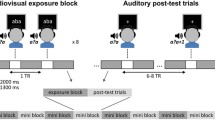Abstract
Five groups of twelve right-handed male children from the second to the sixth grade with normal reading efficiency were tested under three conditions of simultaneous amplified auditory feedback, binaurally, to the left and to the right ear, on reading aboud two separate classes of words, nouns and nonwords. Lateralized feedback was supposed to shift auditory attention towards the source of input and modify as a consequence, the functionality of the contralateral hemisphere. Right ear feedback improved reading accuracy with respect to the control (binaural) or left ear condition in the first three grades. No effect was observed in the fifth grade whereas in the sixth grade, the condition of left ear feedback improved only the reading of nouns. Changes in reading accuracy are interpreted according to an hypothesis of a decrement of the left hemisphere involvement during the course of reading development. These changes are discussed in relation to Frith's (1985) psycholinguistic model of reading acquisition.
Similar content being viewed by others
References
Bakker, D. J. 1988. Invoking precursors of deficient reading. In R. L.Masland and M. W.Masland (Eds) Preschool prevention of reading failure, Orlando, FL: York Press.
Boliek, C. A., Obrzut, J. E. and Shaw, D. 1988. The effects of hemispatial and asymmetrically focused attention on dichotic listening with normal and learning-disabled children. Neuropsychologia, 26, 417–433.
Bradshaw, J. C., Gates, A., and Nettleton, N. C. 1977. Bihemispheric involvement in lexical decision: handedness and a possible sex differences. Neuropsychologia, 15, 277–286.
Coltheart, M. 1985. Right hemisphere reading revisited. The Behavioral and Brain Sciences, 8, 363–379.
Denkla, M., Rudel, R., Broman, M. 1981. Tests that discriminate between dyslexic and other learning-disabled boys. Brain and Language, 13, 118–129.
Francis, D. J. and Fletcher, J. M., Maxwell, S. E., Satz, P. 1989. A structural model for developmental changes in the determinants of reading achievement. Journal of Clinical and Child Psychology, 18, 44–51.
Frith, U. 1985. Beneath the surface of developmental dyslexia. In K.Patterson, J.Marshall and M.Coltheart (Eds) Surface dyslexia. London: Erlboum.
Hermann, H. T., Sonnabend, N. L. and Zeevi, Y. 1986. Interhemispheric coordinations is compromised in subjects with developmental dyslexia. Contex, 22, 337–358.
Leiber, L. 1976. Lexical decisions in the right and left cerebral hemispheres. Brain and Language, 3, 443–450.
Licht, R., Bakker, D. J. Kok, A. and Bouma, A. 1988. The development of lateral eventrelated potentials (ERPs) related to word naming: a four year longitudinal study. Neuropsychologia, 26, 327–340.
Obrzut, J. E., Boliek, C. A. and Obrzut, A. 1986. The effect of stimulus type and directed attention on dichotic listening with children. Journal of Experiemental Child Psychology, 41, 198–209.
Obrzut, J. E., Conrad, P. F. and Boliek, C. A., 1989. Verbal and nonverbal auditory processing among left- and right-handed good readers and reading-disabled children. Neuropsychologia, 27, 1357–1371.
Patterson, K., Vargha-Khadem, F., and Polkey, C. E. 1989 Reading with one hemisphere. Brain, 112, 39–63.
Satz, P., Taylor, M. G., Friel, J. and Fletcher, J. 1978. Some developmental and predictive precursors of reading disabilities: a six year follow-up. In A. L.Benton and D.Pearl (Eds) Dyslexia: an appraisal of current knowledge. New York: Oxford University Press.
Seymour, P., McGregor, C. J. 1984. Developmental dyslexia: a cognitive experimental analysis of phonological, morphemic and visual impairments. Cognitive Neuropsychology, 1, 43–82.
Stanovich, K. E. 1988. Explaining the differences between the dyslexic and the gardenvariety poor reader: the phonological-core variable-difference model. Journal of Learning Disabilities, 21, 590–612.
Tressoldi, P. E. 1987. Visual hemispace differences reflect hemisphere asymmetries. Neuropsychologia, 4, 625–636.
Tressoldi, P. E. 1989. Hemispace and information control by the two cerebral hemispheres: which interaction?. Brain and Cognition, 10, 44–53.
Wilcox, R. R. 1985. An extended and slightly improved table of critical values for testing q linear contrasts in a repeated measures design. Comm. Stat. Simul. Comp. 14, 55–69.
Author information
Authors and Affiliations
Rights and permissions
About this article
Cite this article
Tressoldi, P.E., Vio, C. & Scotti, P. Effects of simultaneous auditory feedback on reading accuracy during reading development. Read Writ 3, 151–158 (1991). https://doi.org/10.1007/BF00420031
Issue Date:
DOI: https://doi.org/10.1007/BF00420031




